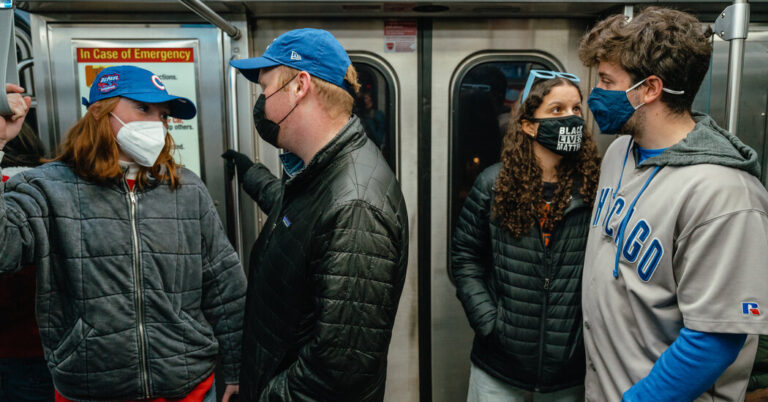An Early Heat Wave Upsets the Rhythm of Life in the South
The drum line stood beneath a canopy of trees and rattled through rolls of sextuplets, with reddened shoulders glistening. As the sun blistered the parking lot, rows of trumpet, tuba and mellophone players marched back and forth, wiping sweat from their foreheads at the end of each passage of music.
Temperatures here in Daphne, Ala., had climbed past 90 degrees, and the humidity made it feel at least 10 degrees hotter. Yet even as a record-breaking heat wave seared most of the American South this week, the members of the Southwind Drum and Bugle Corps chose to push on, not wanting to miss a moment of the intensive camp they had been waiting all year for.
“The heat has gotten me once or twice this season,” said Gracie Binns, an 18-year-old member of the color guard. “It’s kind of worn me down already.” But, she added, “I like the challenge of it.”
This is summer in the South. The heat is pervasive, and demands adaptation. Construction workers, landscapers and delivery drivers wear cooling rags underneath their wide-brimmed hats, and some even turn to Florida water — a citrus-scented, alcohol-based cologne — to help cool their necks. Dog walkers, joggers, farmworkers and almost everybody else know it’s best to venture out in the early mornings or the evenings.
But after a significantly warmer June, and with climate change driving temperatures ever higher, this longstanding patchwork of medical and homemade remedies is becoming increasingly crucial for the preservation of both livelihoods and summer traditions.
Ahead of the Fourth of July holiday, the stifling humidity was set to persist along the Gulf of Mexico, maintaining hazardous and sweltering conditions even as temperatures began to drop a few degrees. And while the humidity should be lower in the West, Central California and places in the desert Southwest will also endure a blast of heat this weekend.
In the South, the early heat wave has heightened familiar fears about heat stress and dehydration and added some new concerns. The combination of heat and dryness in the small town of Erath, La., at one point raised questions about the safety of the annual fireworks show.
“That thought is unbelievable,” said Leslie Mencacci, the president of Erath’s Fourth of July Association. “We’ve never had this issue.”
Accommodations are in place across the region: earlier start times for postal workers, more jugs of blue Gatorade at a summer camp on the shores of a Texas lake, and the opening of cooling centers in Tennessee, Texas and Mississippi.
“All we can do is better prepare for it because unfortunately it’s here and it’s not going anywhere,” said Sonny Schindler, the owner of Shore Thing Fishing Charters in Mississippi, who has been waking up at 2:30 a.m., an hour early, for a cooler start.
On the sprawling campus of Daphne High School, near Mobile, there was no question the heat felt worse this year. The musicians kept one another updated with heat index readings and data on how quickly the sun might burn them. Just days into a three-week camp, sunburns had begun to blister, and awkward tan lines marking socks, watches, sleeves and shoe straps were deepening.
But band would continue, with barely two weeks left before they were set to trek across the country and compete in a series of performances.
“The reward is definitely very delayed,” said Sophia Farfante, 19, the lone woman hoisting a tuba over her shoulder each day. “You’re here for three weeks, putting in all the work, working your butt off, sweating. But when you get the show on the field, and you start looking back at videos of you performing the show, and you start remembering the things that you did, and the traditions you got to share and all that — it really means the world.”
This stretch of summer is crucial for Southwind, one of 40 marching ensembles that compete under Drum Corps International, which has maintained the nation’s post-World War I tradition of civilian drum and bugle corps. Tuition for the entire year, including lodging, uniforms, food and travel during practice and to each competition, is about $4,200.
After months of auditions and more scattered practices during the winter months, these weeks are the opportunity for the musicians to drill down on the intricacies and precision of a roughly 10-minute medley and its accompanying choreography on a football field.
The musicians can practice their melodies and train their lung capacities inside, often to the insistent clacking of metronomes. Yet there is little substitute for the hours spent outside rehearsing how to crisscross the field in unison, incorporate towering set pieces and, importantly, avoid collisions with equipment and one another.
“It’s like believing in an experience,” said Lucas Houston, 16, a mellophone player from Hernando, Miss. “Every single second you spend feels sentimental in a way.”
Heat, however, remains perhaps the most insidious threat in a stretch of 12-hour days that are often riddled with injuries and emotional stress, including fingers broken and battered by twirling rifles and flags, strained hamstrings, performance anxiety, homesickness and fire ant bites. Even at night, when members of the ensemble come together to rehearse entire sections of their performance, the humidity keeps them sweating, with little opportunity to cool down.
And spare a thought for the drummers.
“It makes you want to put them back down immediately,” said Brenden Wickliffe, an 18-year-old music education student who compared carrying the weight of his six drums to keeping a barbell behind his back before a squat. “I’m just soaking wet from start to finish.”
Some of the instructors recalled instances from their own drum corps days when water breaks were not encouraged or outright withheld as punishment for a subpar rehearsal.
But as education practices have evolved, those tactics have disappeared. The corps keeps an athletic trainer and several medical volunteers on site, and performers were hustled inside when it became clear the heat index was spiking. The instructors insist on pausing for water when heat is visibly taking a toll, oversee breaks in the shade, and counsel performers to listen to their bodies.
By the fifth day of camp, some of the medical volunteers still appeared slightly bemused by the enthusiasm of their patients, particularly as temperatures climbed.
“I’m on the sidelines dripping from every crevice,” said Makayla Chrismon, a 27-year-old medical student among those keeping a watchful eye on the musicians. “And they don’t even look grumpy about it.”
On Wednesday, T’Yanna Williams, an 18-year-old member of the color guard, felt her body get heavy after a short rehearsal outside in the sun. Within minutes, she was lying on her back inside the air-conditioning, her friends and instructors fanning her, handing her water and assuring her that it was worth taking a few minutes now rather than risk jeopardizing the rest of the season.
About 30 minutes later, she was back in the ranks, twirling and spinning a rifle high above her head.
“I just love the feeling of performing and having a support group to be there with me,” Ms. Williams said afterward. “You either full-on commit to it, or you don’t. You kind of get what you put into it.”
In a food truck, cooks strategized about the salads, fruit and pastas that could help cool down the musicians, writing warnings to “Hydrate!!!” and “Apply sunscreen!” next to the day’s menu on whiteboards.
“When it snows here, the world stops turning,” said Jeff Parsons, a member of the cooking staff, as he prepared to position a vat of a peanut butter and jelly mixture in the shade of a tree for lunch. In the heat, he added, “life goes on.”
Marie Elizabeth Oliver, Stacey Cato and Mary Beth Gahan contributed reporting.
Check out our Latest News and Follow us at Facebook
Original Source







